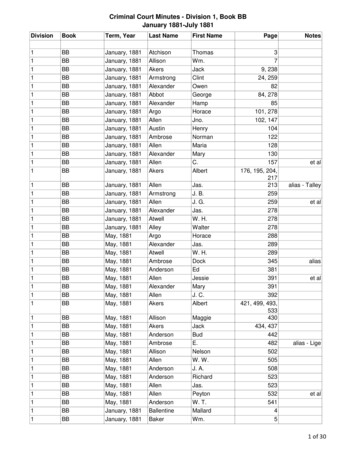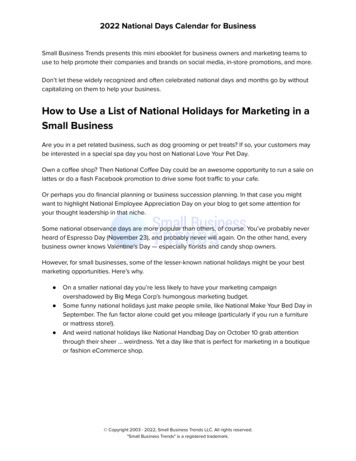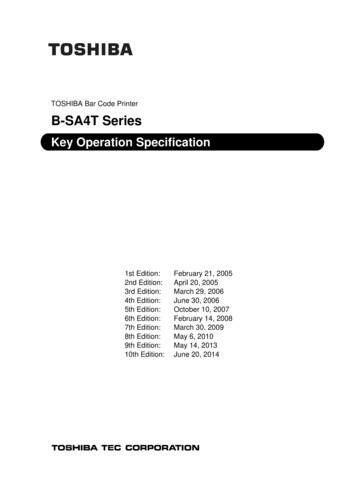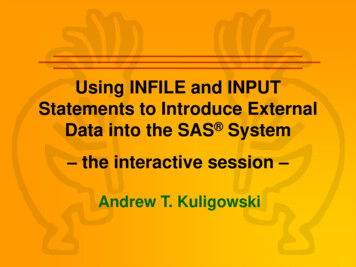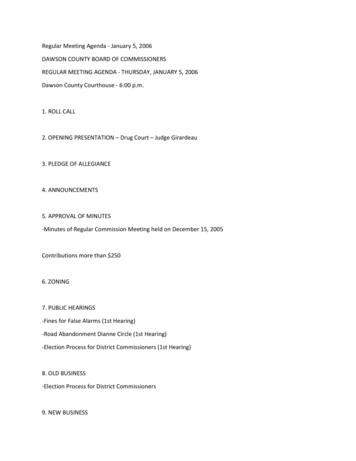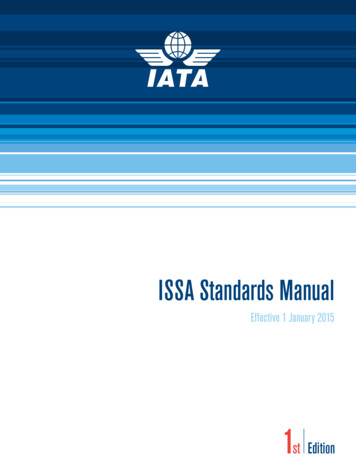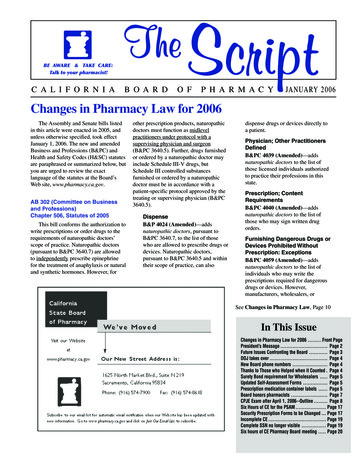
Transcription
Cf(iBE AWARE & TAKE CARE:Talk to your pharmacist!C A L I F O R N I AB O A R DO FP H A R M A C YJA N AU RY 20062005JANUARYChanges in Pharmacy Law for 2006The Assembly and Senate bills listedin this article were enacted in 2005, andunless otherwise specified, took effectJanuary 1, 2006. The new and amendedBusiness and Professions (B&PC) andHealth and Safety Codes (H&SC) statutesare paraphrased or summarized below, butyou are urged to review the exactlanguage of the statutes at the Board’sWeb site, www.pharmacy.ca.gov.AB 302 (Committee on Businessand Professions)Chapter 506, Statutes of 2005This bill conforms the authorization towrite prescriptions or order drugs to therequirements of naturopathic doctors’scope of practice. Naturopathic doctors(pursuant to B&PC 3640.7) are allowedto independently prescribe epinephrinefor the treatment of anaphylaxis or naturaland synthetic hormones. However, forother prescription products, naturopathicdoctors must function as midlevelpractitioners under protocol with asupervising physician and surgeon(B&PC 3640.5). Further, drugs furnishedor ordered by a naturopathic doctor mayinclude Schedule III-V drugs, butSchedule III controlled substancesfurnished or ordered by a naturopathicdoctor must be in accordance with apatient-specific protocol approved by thetreating or supervising physician (B&PC3640.5).DispenseB&P 4024 (Amended)—addsnaturopathic doctors, pursuant toB&PC 3640.7, to the list of thosewho are allowed to prescribe drugs ordevices. Naturopathic doctors,pursuant to B&PC 3640.5 and withintheir scope of practice, can alsodispense drugs or devices directly toa patient.Physician; Other PractitionersDefinedB&PC 4039 (Amended)—addsnaturopathic doctors to the list ofthose licensed individuals authorizedto practice their professions in thisstate.Prescription; ContentRequirementsB&PC 4040 (Amended)—addsnaturopathic doctors to the list ofthose who may sign written drugorders.Furnishing Dangerous Drugs orDevices Prohibited WithoutPrescription: ExceptionsB&PC 4059 (Amended)—addsnaturopathic doctors to the list ofindividuals who may write theprescriptions required for dangerousdrugs or devices. However,manufacturers, wholesalers, orSee Changes in Pharmacy Law, Page 10In This IssueVisit our Websiteatwww.pharmacy.ca.gov Our New Street Address is:1625 North Market Blvd., Suite N 219Sacramento, California 95834Phone: (916) 574-7900Fax: (916) 574-8618Subscrib, to our ,mail list for automatic em,al nobfication when our Web site has been updated withnew informabon . Go to www .phatmacy.ca.gov and click on pn01irEmal lirt.to subscrib, .Changes in Pharmacy Law for 2006 . Front PagePresident’s Message . Page 2Future Issues Confronting the Board . Page 3DOJ takes over . Page 4New Board phone numbers . Page 4Thanks to Those who Helped when it Counted . Page 4Surety Bond requirement for Wholesalers . Page 5Updated Self-Assessment Forms . Page 5Prescription medication container labels . Page 5Board honors pharmacists . Page 7CPJE Exam after April 1, 2006--Outline . Page 8Six Hours of CE for the PSAM . Page 17Security Prescription Forms to be Changed . Page 17Incomplete CE . Page 19Complete SSN no longer visible . Page 19Six hours of CE Pharmacy Board meeting . Page 20
2BOARD OF PHARMACYJANUARY 2006QUESTION: How many colleges or schools of pharmacy are in California?ANSWER: SEVEN, and they are:Loma Linda University School of PharmacyWest Hall 131611262 Campus StreetLoma Linda, CA 92350(909) 558-7442Thomas J. Long School of Pharmacy &Health Sciences at the University of the Pacific3601 Pacific AvenueStockton, CA 95211(209) 946-2561Touro University - California College of Pharmacy1310 Johnson LaneMare IslandVallejo, CA 94592(707) 638-5221President’s MessageBy Stanley W. Goldenberg, R. Ph.President, Board of PharmacyMy message today is dedicated anddirected to those who are the future ofpharmacy—our students. Consequently,this issue will be mailed to each studentregistered as an intern with the Board. Ialso am asking all pharmacies andpharmacists to share their newsletterswith a pharmacy student.Preceptors are vitally important to theeducation and training of futurepharmacists. California law now allows apharmacist to supervise up to two internpharmacists. I encourage every practicingpharmacist to call a college or school ofpharmacy near you, and ask if you canhelp with their preceptor program.During my presidency, I have madespecial efforts to include pharmacystudents in the workings of the Board bysending letters to the California schoolsand colleges of pharmacy, invitingstudents and faculty to attend the Boardmeetings. I am pleased to note thatstudents have been attending thesemeetings. (Registered pharmacists andpharmacy technicians can obtain sixhours of continuing education credit forattending.)Board and committee meetings areheld quarterly in various areas of thestate, and your attendance andUniversity of California, San Diego, Skaggs School ofPharmacy and Pharmaceutical Sciences9500 Gilman Drive, MC 0657La Jolla, CA 92093-0657(858) 534-1366University of California, San Francisco, School of Pharmacy521 Parnassus Avenue, Room C-156Box 0622San Francisco, CA 94143-0622(415) 476-1225University of Southern California School of Pharmacy1985 Zonal AvenueLos Angeles, CA 90089-9121(323) 442-1369Western University of Health Sciences College of Pharmacy309 E. Second StreetPomona, CA 91766-1854(919) 469-5581participation in these meeting isencouraged and welcome. There is noadvance reservation needed or feecharged for attending. More detailedinformation is available on the Board’sWeb site. Board meeting dates andlocations for 2006 are listed on page 20.WHY SHOULD YOU ATTEND?A major reason for attending theBoard meetings is to become involved inthe future of pharmacy. By attending themeetings you will learn the systemswithin which the Board must operate andthe Board’s procedures. You will becomeaware of California and nationalpharmacy issues, including areas wherethe National Association of Boards ofPharmacy comes into play. By beingfamiliar with this landscape, you canunderstand how pharmacy laws aredeveloped and contribute to thatdevelopment with knowledge. Thisinformation will give you an “edge” inthe marketplace, no matter what aspect ofpharmacy you practice.The Board needs input from allstakeholders so that its members canmake fully informed decisions, and thosedecisions will enable you to contribute tothe public health and well-being of allSee President’s Message, Page 3
JANUARY 2006President’s MessageContinued from Page 2Californians. Your professional life willbe influenced not only by pharmacy lawbut also by knowledge acquired outsidethe school. Your input and contributionswill influence the direction yourprofessional career takes.I invite you to attend a Board ofPharmacy meeting and help shape thefuture for us all. However, for those whocannot attend, you can participate in theBoard’s strategic planning process bycompleting a stakeholder’s survey,available online in March 2006. For moreinformation regarding the survey, pleasesee “Future Issues Confronting the Boardand its Regulatory Role to ProtectConsumers” below.BOARD OF PHARMACYCPJE Update: As you know, tobecome a registered pharmacist inCalifornia, you are required to pass boththe North American Pharmacist LicensureExamination (NAPLEX) and theCalifornia Pharmacist JurisprudenceExamination (CPJE). Questions for theCPJE are developed according to acontent outline that is developedfollowing a job analysis of the pharmacistprofession in California. The Boardconducted its most recent job analysis inlate 2004 and developed a new contentoutline in 2005. Questions generated bythe content outline will be used toconstruct the CPJE, beginning with CPJEexams administered on and after April 1,2006. A copy of the new content outline3can be found on Page 8. The outline isalso available on the Board’s Web site,www.pharmacy.ca.gov, then click on“Written Information & Research Tools,”then “Pharmacist Exam,” then “CaliforniaSpecific Examination CPJE ContentOutline for CPJE Exams given on or afterApril 1, 2006.”On behalf of the Board of Pharmacy,I’d like to extend our wishes to all for ahappy and healthy New Year!Future Issues Confronting the Board and its RegulatoryRole to Protect ConsumersYour comments are sought and needed!In late March, the Board will offer a survey on its Web site seeking comments fromthe public, from the profession and from interested individuals. We will be seekinginput on future issues facing the Board, the practice of pharmacy and patientsconcerning prescription medication. These comments will be integrated into theBoard’s strategic plan, as part of the factors to be considered when developing policyinitiatives that will protect the public. The Board is undertaking a major review of itsstrategic plan this year, and these issues are important in developing a meaningful plan.There will be a short time frame to provide these comments, which is why theBoard’s Web site will be used. To make certain you are notified when the survey isavailable, please become a subscriber to our Web site. It is easy; simply go the Board’sWeb site, click on “Join our e-mail list,” and you will be notified via an e-mail alertwhen the survey is ready.Additionally, the Board will create a special mailing list for this survey. To requestthat a survey be mailed to you, please send your name and address to Board ofPharmacy, 1625 N. Market, Suite N-219, Sacramento, CA 95834, Attn: StakeholderSurvey. We will mail you the survey once it is available.Thank you in advance for your comments and participation.
4BOARD OF PHARMACYDOJ takes over approval processof security printer applicationsJANUARY 2006Our Thanks to Those whoHelped when it CountedOn January 1, 2006, the Board of Pharmacy transferredthe review and approval of applications to become securityprescription printers to the Department of Justice, pursuant toSB 734 (Torlakson), Health & Safety Code sections 11161.5and 11162.1. All new applications must be sent to the DOJand applications already pending with the Board have beenforwarded to the DOJ for final review and approval. The DOJwill maintain a list of approved security printers.Details of the DOJ’s responsibilities relating to securityprinter applications are outlined in “Changes in PharmacyLaw for 2006” on Page 12.Please mail current applications and direct any inquiries to:Department of Justice/Bureau of Narcotic EnforcementCA Security Prescription Printer ProgramP. O. Box 161089Sacramento, CA 95816-1089Phone: (916) 319-9062Fax: (916) 319-9448New Phone Numbers at the BoardWhen the Board of Pharmacy moved to the new location, ourphone system and numbers changed: The main telephone numberis (916) 574-7900, but staff members now have their ownindividual phone numbers instead of extension numbers. For yourconvenience, we are listing a few of the most frequently calledstaff members and their numbers.For site licenses (pharmacies, hospitals,Brenda Cartwrightclinics, licensed correctional facilities,(916) 574-7943wholesalers and nonresident wholesalers),Changes of Permit and duplicate sitelicenses:For site licenses (pharmacies, hospitals,clinics and sterile compounding facilities,PIC changes and discontinuances ofbusiness:Suelynn Yee(916) 574-7945For the pharmacist licensure exam,Amber Crosbyduplicate personal licenses, wall(916) 574-7936certificates, license verifications, transfer ofintern hours, and pharmacists from foreigncountries:For pharmacy intern and pharmacytechnician applications:Angel Kenoly(916) 574-7937For Board and Committee meetingsinformation:Candy Place(916) 574-7912Other staff numbers can be obtained via recorded instructions on theBoard’s main number.Michael J. Sohmer, R.PH., DMAT-San Diego, and familywith Stanley Goldenberg, President, Board of PharmacyFollowing the tragedy of September 11, 2001, anarticle describing the role of the pharmacist as a memberof a Disaster Medical Assistance Team (DMAT) wasincluded in The Script.DMAT members are intermittent federal employees(who have full time jobs elsewhere) and subject toresponding to medical disasters. Teams consist of about 35people including doctors, nurses, pharmacists, securitypersonnel and others who deploy usually for 14 days withtents, generators, medical supplies, drugs, etc., and areexpected to be self-sufficient for the first 72 hours. TheBoard wishes to recognize one such team of pharmacistsand pharmacy technicians and share their heroic actionswith you.The following account was provided by the teamleader, Charles Valencia, Pharm.D., of Port Orchard, WA.His assistant, Michael Sohmer, RPh, Craig Steinberg,Pharm.D., Dana Lee, Pharm.D., Susana Leung, RPh, andpharmacy technician Michael D. Jones were all fromCalifornia. Other out-of-state team members included:Cynthia Parks, RPh (OR)Bonnie Vance, RPh (AL)Jim Gervase, RPh (PA)Dana Hurley, RPh (WA)Emelio (Mel) Mastrodomenico, RPh (MA)Craig Lequatte, RPh (USAF)Jim Condron, Pharm Tch (USAF)Lou Gutfleish, RPh (FL)Colleen Grunow, RPh (OR)Vickie Delgado, RPh (TX)Kevin McEnaney, RPh (MA)Kitty Dreisbach, Pharm Tch (PA)Jodi Grim, RPh (NV)Bill Drake, RPh (MI), was not among those deployedto the New Orleans Airport, but he played a critical roleSee Thanks to those who helped, Page 5
JANUARY 2006Thanks to thosewho helpedContinued from Page 4serving as a regional pharmacysupervisor coordinating not only theairport pharmacy operation but alsopharmacists at other team deployments.The team was deployed and afterseveral stops, established a medical baseof operations inside the New OrleansAirport lobby on 08/31/05. For the first36 hours they had no power (only limitedemergency power and their owngenerator power) and no potable water. Apharmacy was set up outside in a FedEx24 ft. refrigerated truck which containeda FEMA pharmacy cache.However, before being fully set up,they started to receive large numbers ofmedical casualties and evacuees fromNew Orleans. The evacuees arrived byhelicopters, paramedic ambulances,buses, and private cars. Helicopters werelanding 4-6 at a time (stopping only longenough to unload and take off again), andthere was a line of ambulances stretchingall the way down the airport ramps, andbusloads of nursing home, hospice andother patients.The operation started with fivepharmacists and one technician workingnonstop to operate a 24-hour pharmacy.Most of the team had little or no sleepduring the first 60 hours. After airportpower was restored, the pharmacyoperation moved to a bar inside theterminal (The Legends Bar and Grill)where the pharmacy area became knownas “The Barmacy.”In the first few days, the team ran outof a lot of drugs including some ACLSdrugs, and at one point had no opiatepain medicine for 6-8 hours. There weremany patients (nursing home andhospice) for whom they could do little ornothing. They treated some very sick,life-threatening cases (heart attacks, etc.),delivered some babies, and treated manyurgent-care wounds and serious injuries.They also triaged and provided three-daysupplies of medication for thousands ofpatients who had run out of maintenancemedications. One USAF Gulf WarSee Thanks to those who helped, Page 18BOARD OF PHARMACY5Surety Bond requirement for Wholesalersand Nonresident Wholesalers beganJanuary 1, 2006Beginning January 1, 2006, wholesalers and nonresident wholesalers must post a 100,000 bond or other means of security acceptable tothe Board before they can be issued an original wholesaler license orrenew their current licenses. Instead of the bond, applicants can submitother equivalent means of security acceptable to the Board, including astandby letter of credit or cash deposit.The surety bond form that wholesalers may need to complete isnow available on the Board’s Web site, www.pharmacy.ca.gov, as isinformation about the other means of security acceptable to the Board.Please Note: The law provides that wholesalers with less than 10million in annual sales may qualify for a 25,000 bond (instead of 100,000). The surety bond form for this group is still undergoingreview by the Administration, which requires the approval of the Officeof Administrative Law. We hope to have approval of this bond form inplace before April 1.Individuals with questions may e-mailBrenda Cartwright@dca.ca.gov or Anne Sodegren@dca.ca.gov.Updated PharmacySelf-AssessmentForms AvailableOnlineCalifornia Code of Regulationssection 1715 requires the pharmacist-incharge (PIC) of each Californiapharmacy to complete a self-assessmentof the pharmacy’s compliance withfederal and state law. The assessmentmust be performed before July 1 of eachodd-numbered year and within 30 dayswhenever (1) a new pharmacy permit hasbeen issued or (2) there is a change in thePIC. There are separate forms forcommunity and for inpatient pharmacies,which can be downloaded from theBoard’s Web site, www.pharmacy.ca.gov.The latest version of the selfassessment was formally adopted as aboard regulation in early October 2005.Pharmacies are expected to be using the2005 version of the self-assessment formto assess their compliance with state andfederal laws. Board inspectors willcontinue to check for completion of the2005 self-assessment form duringinspections.Prescriptionmedicationcontainer labelsmust containphysical descriptionof the drugOn January 1, 2006, a newrequirement for labels on prescriptioncontainers dispensed from outpatientpharmacies became effective. Thisrequirement is the physicaldescription of the dispensedmedication, including its color, shapeand any identification code thatappears on the tablets or capsules,pursuant to Business & ProfessionsCode section 4076(a)(11)(A).For example, a prescription labelfor Ibuprofen Tab 400mg mightinclude the notation, “This medicine isa white, oval-shaped, film-coatedtablet imprinted with IBU 400.” Alabel for Pravachol might include,“Square yellow tablet, Side 1: P, Side2: PRAVACHOL #20.”See Prescription container, Page 19
6BOARD OF PHARMACYJANUARY 2006Board honorees and guests
JANUARY 2006BOARD OF PHARMACYBoard honors pharmacistsregistered for at least 50 yearsIn an ongoing feature of The Script, the Board wishes to paytribute to those who have been registered California pharmacistson active status for at least 50 years. The Board of Pharmacyrecognizes these individuals and gratefully acknowledges theiryears of contribution to the pharmacy profession. Thesepharmacists may take great pride in being part of such anancient and honorable profession for so long.Fifty additional pharmacists were recently awardedcertificates commemorating 50 years of service and invited toattend future Board meetings where they could be publiclyhonored. At least 18 honorees attended the October meeting, andwe are pleased to share some of their comments with you. John R. Kenny, Jr., who graduated from pharmacy school in1943, traveled from Maryland to attend the Board meeting. Anderson, Jr., Oliver RBaker, NubertBehler, Robert DCholakian, GeorgeChow, Calvin CCostello, Kenneth RElkin, EugeneEspinosa, William CFarnworth, Glenn TGelfand, SanderGrimstead, Donna LHays, Fern LHill, Donald EHiura, Robert AJones, Stanley FKato, Shigemi MKenwood, FrankKobayashi, EarlKuschnereit, MiltonLawrence, Gregson DLee, David SLeonard, Oscar LLester, Leland KLew, WilliamMcDougald, Charles AMcIntosh, Earl GMoreno, Oswald JNeumen, Joseph RPallares, OscarPersson, Niles LPetersen, Wayne APeterson, Lawrance LPetrulakis, AnthonyPlake, John HPotash, StanleyPullen, Robert JRotenberg, Joseph ISain, Kenneth ESarboraria, John ASchieser, David WShahin, Philip HSheu, GeorgeSiouris, George CSteo, Daniel FTakeda, Edward KTurner, George WWilson, Byron NWright, Richard WZosel, Jr., Harold ASan Rafael, CAFresno, CAStockton, CAFresno, CABurlingame, CABrentwood, CARiverside, CAYucaipa, CARocklin, CAHuntington Beach, CAMurphys, CAHealdsburg, CAPleasanton, CAWest Covina, CAFresno, CALos Angeles, CAPacific Grove, CASan Mateo, CASacramento, CAMontague, CALos Angeles, CAParadise, CACastro Valley, CARancho Palos Verdes, CACorcoran, CASan Jose, CASanta Barbara, CARedlands, CAGlendale, CAMadera, CAHemet, CASanta Rosa, CAModesto, CASequim, WALos Angeles, CAVisalia, CATiburon, CAAltadena, CALivermore, CASausalito, CAApple Valley, CASan Gabriel, CAElk Grove, CANorthridge, CASan Jose, CASage, ARCrescent City, CASan Jose, CAPleasanton, CA 7Mr. Kenny praised the profession, is licensed in six statesand still working as a pharmacist.Wayland C. Fuller and his daughter thanked the Board andnoted that he had owned his own pharmacy from 1962 to1998. He continues to renew his license and obtaincontinuing education credit.George T. Golish began working at Walgreens at age 10 andacknowledged that Walgreens put him through college. Heowned his own pharmacy for 24 years in Castro Valleywhere he enjoyed the pharmacy profession very much.Billy Bob Speck, a 1953 graduate of UCSF, was working(he owns three independent pharmacies in Richmond,California) and could not be present, but his recognition bythe Board was accepted by his grandson who is alsopursuing a career in pharmacy.Nicholas J. Ivans, a graduate of USC and licensed in 1950,and his wife are both pharmacists. In 1954, Mr. Ivans wasparalyzed by Polio, but with his wife’s assistance, theymanaged to keep their pharmacy open. He added that heloved the pharmacy profession and the people he met.Richard G. Barberian, licensed in 1953, owned aneighborhood pharmacy for 38 years. Mr. Barberian notedthat the profession represents a health care bargain forpatients and thanked the Board for its recognition of hisservice.William A. Rose was able, through the GI Bill of Rightsfollowing World War II, to obtain his pharmacy education atOregon State University in 1952 and eventually settled inModesto. Mr. Rose thanked the Board.William A. Siskin, a graduate of UCSF in 1940, was aregistered pharmacist for 65 years and owned his ownpharmacy for 31 years. He added that he was proud of hisprofession and enjoyed his relationship with his customers.Robert D. Gibson, a University of Oregon graduate in 1954,stated that he had enjoyed a successful and rewarding careerand recommended the profession to students present at themeeting. He also noted that he was very proud of BoardMembers Ruth Conroy, Ken Schell and Dave Fong, whowere former students of his.Robert A. Brown graduated from Purdue University in 1951and owned a pharmacy in Culver City for 25 years. Herecommended to those interested in a pharmacy career toopen a small compounding pharmacy.Burt Freeman noted that he was a second-generationpharmacist and was in the first graduating class atNortheastern University (Massachusetts) to test for apharmacist license in 1954. He also thanked the Board forthis recognition.Frederick S. Mayer was licensed in 1954 and owned his ownpharmacy in Sausalito, California, for 40 years. Mr. Mayerpraised the pharmacy profession and stated that he hadenjoyed his career. He acknowledged the students in theaudience and thanked the Board for honoring him.Howard J. Murphy graduated from USCF and was licensedin 1952. He thanked the Board for this recognition andSee Honored Pharmacists, Page 18
8BOARD OF PHARMACYJANUARY 2006California Pharmacist Jurisprudence Exam (CPJE)Content Outline (4/1/06)Questions for the CPJE exam to be administered on or after 4/1/06 will bedeveloped from the following criteria (based on a job analysis of the pharmacistprofession in California in 2004).1. Provide Medication to Patients25 ItemsA. Organize and Evaluate Information1. Interpret prescription/medication order2. Obtain information from the patient/patient’s representative for patientprofile (diagnosis or desired therapeutic outcome, allergies, adversereactions, medical history, etc.)3. Obtain information from prescriber and/or health care professionals forpatient profile (diagnosis or desired therapeutic outcome, allergies, adversereactions, medical history, etc.)4. Assess prescription/medication order for completeness, correctness,authenticity, and legality5. Assess prescription/medication order for appropriateness (e.g., drugselection, dosage, drug interactions, dosage form, delivery system)6. Evaluate the medical record/patient profile for any or all of the following:disease states, clinical condition, medication use, allergies, adversereactions, disabilities, medical/surgical therapies, laboratory findings,physical assessments and/or diagnostic tests7. Evaluate the pharmaceutical information needs of the patient/patient'srepresentativeB. Dispense Medications1. Enter prescription information into patient profile2. Prepare IV admixtures3. Document preparation of medication in various dosage forms (e.g.,compounded, unit dose)4. Document preparation of controlled substances for dispensing5. Verify label(s) for prescription container(s)6. Select auxiliary label(s) for container(s)7. Perform the final check of the medication prior to dispensing2. Monitor and Manage Patient Outcomes25 ItemsA. Determine a Course of Action and Manage Patient Outcomes1. Determine desired therapeutic outcomes2. Develop a therapeutic regimen for prescription medications (e.g.,recommend alteration of prescribed drug regimen; select drug if necessary)3. Determine the need for a referral4. Communicate the therapeutic plan to the patient/patient’s representative,the prescriber and other health care professionals5. Recommend/order necessary monitoring and screening procedures (e.g.,blood pressure, glucose levels, drug levels)6. Communicate results of monitoring to patient/patient’s representative,prescriber and/or other health care professionals7. Manage drug therapy according to protocols
JANUARY 2006BOARD OF PHARMACYB. Educate Patients and Health Care Professionals1. Assess the patient’s understanding of the disease and treatment2. Counsel patient/patient’s representative regarding prescription medicationtherapy and devices3. Counsel patient/patient’s representative regarding nonprescriptionmedication (OTC)4. Counsel patient/patient’s representative regarding herbal/complementarytherapies5. Counsel patient/patient’s representative regarding non-drug therapy6. Counsel patient/patient’s representative regarding self-monitoring of therapy(e.g., devices, symptoms)7. Verify the patient’s/patient representative’s understanding of the informationpresented8. Educate health care professionals (e.g., physicians, nurses, medicalresidents/fellows, other health care providers/students, precepting internpharmacists)3. Manage Operations25 ItemsA. Procure Pharmaceuticals, Devices and Supplies and Control Inventory1. Place orders for pharmaceuticals, durable medical equipment, devices andsupplies, including expediting of emergency orders2. Maintain a record-keeping system of items purchased/received/returned incompliance with legal requirements3. Maintain a record of controlled substances ordered, received, stored andremoved from inventory4. Store pharmaceuticals, durable medical equipment, devices and suppliesunder proper storage conditions5. Dispose of expired or recalled pharmaceuticals, durable medical equipment,devices, supplies and document actions taken6. Communicate changes in product availability (e.g., formulary changes,recalls, shortages) to pharmacy staff, patient/patient’s representative,physicians and other health care professionals7. Maintain policies and procedures to prevent theft and/or drug diversionB. Perform Quality Assurance/Improvement1. Assess pharmacist and/or pharmacy technician competence2. Ensure the accuracy of medication administration3. Implement a system for medication error prevention, assessment, andreporting (e.g., root cause analysis, National Patient Safety Goals)4. Implement a system by which adverse drug reactions are documented,analyzed, evaluated and reportedC. Manage Operations, Human Resources and Information Systems1. Monitor the practice site and/or service area for compliance with federal,state and local laws, regulations and professional standards2. Supervise the work of pharmacy staff3. Ensure the availability, control, and confidentiality of patient and prescriptioninformation (e.g., patient profiles, medication administration records)D. Manage Medication Use System1. Maintain a formulary system2. Apply therapeutic interchange3. Conduct medication use evaluationsTOTAL: 75 questions plus 15 unscored pretest items9
10BOARD OF PHARMACYChanges inpharmacy lawprocedure, protocol or practiceagreement that includes specificapproval by a physician.Continued from Page 1Prescription Container –Requirements for LabelingB&PC 4076 (Amended)—prohibitsa pharmacist from dispensing anyprescription in a container that is notcorrectly labeled and does not meetstate and federal law. If prescribed bya naturopathic doctor, his or hername must be included in thecontainer’s label. However, if apharmacist dispenses a dangerousdrug or device in a facility licensedpursuant to H&SC 1250, it is notnecessary to include on individualunit dose containers for a specificpatient, the name of the naturopathicdoctor who functions under astandardized procedure or protocoldeveloped by the naturopathic doctorand his or her supervising physician(B&PC 3640.5).pharmacies may furnish dangerousdrugs or devices to a naturopathicdoctor pursuant to B&PC 3640.7without a prescription, but mustmaintain all sales and purchaserecords on the transaction.Who May Order DangerousDrugs or Devices: Exceptions;Compliance With Laws of AllInvolved JurisdictionsB&PC 4059.5 (Amended)—allowsa dangerous drug or device to beordered by and provided to anaturopathic doctor acting pursuantto B&PC 3640.7. Recipients of thedangerous drugs or devices must beauthorized by law to receive thedrug
Examination (CPJE). Questions for the CPJE are developed according to a content outline that is developed following a job analysis of the pharmacist profession in California. The Board conducted its most recent job analysis in late 2004 and developed a new content outline in 2005. Questions generated by the content outline will be used to




